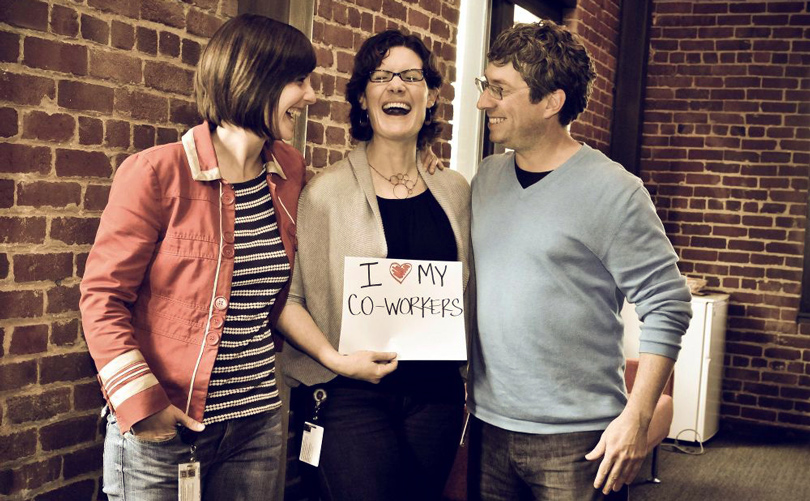Almost all of us need to manage feelings of anxiety in the workplace from time to time.
Important presentations, high-impact decisions and interpersonal conflicts are all common triggers for anxiety in the office. However, for some people, anxiety isn’t a feeling that happens only when the stakes are high; it’s a feeling that happens as consistently and routinely as other people feel tired. Mental health has historically been stigmatised in the workplace, and as a result, it has silenced those who suffer with conditions like anxiety from bringing their full self to the workplace.
This is a problem for multiple reasons, and it’s becoming an increasing issue as cases of anxiety are increasing among adults in the United States, year over year. Less than half of Americans with diagnosed mental health conditions received treatment in one study year. One potential reason for this beyond the stigma alone is lack of access to low- or no-cost mental health care in the United States, creating barriers of privilege between those who can formally receive accommodations for anxiety and those who continue to struggle. This creates a socioeconomic barrier to workplace success for people with undiagnosed anxiety disorders. Moreover, women are more than twice as likely as men to have an anxiety-related condition, and the most common result of anxiety in the workplace is impaired job performance. With so much attention on the lack of women in key leadership roles in business and politics, it’s worth a deeper look at the connection between anxiety its impact on workplace outcomes.
The Bright Side Of Anxiety
Anxiety can actually make people better employees in multiple ways. According to Dr. Alice Boyes, there is certainly a silver lining to managing anxiety. Because people with anxiety struggle with loss of control, they’re more likely to have a plan B when things go wrong, follow up with people when things don’t feel right and lead with positivity despite “OK” outcomes because they expected the worst. Additionally, research has found that anxiety is positively correlated with intelligence.
However, people who struggle with anxiety know it can be paralysing and impact their ability to think clearly and do their best work. The same condition that can make someone exceptionally effective can also effectively paralyse their performance. And what’s more, nearly 1 in 5 adults in the United States struggle with an anxiety disorder.
Five Things Employers Can Do
1. Normalise mental health issues in the workplace. Encourage leadership to openly support these issues; offer events and programs, and allow mental health to enter the company culture narrative. Consider small shifts, like rotating company-sponsored happy hours with company-sponsored healthy hours.
2. Provide and (publicise) benefits and perks that foster all dimensions of health. Most medical benefit plans include some level of coverage for mental health, but it’s not often called out or publicised. Consider the level at which available plans provide coverage, and consider the potential business ROI by increasing or supplementing that coverage.
3. Coach managers to utilise the human resources team as a strategic partner on issues around psychological safety in the workplace.
4. Encourage employees to use time off as a way to manage stress. Mental health days should be as normalised as taking time off for a dental appointment, and some time outside of work stress to focus on self-care is a win for the business and the employee.
5. Be flexible and open. What works at one company environment may be enough, but another company environment may require more. What one employee with anxiety needs will differ from another. Companies should be open and flexible with how they support these issues.
Employees Can Advocate, Too
Unfortunately, not everyone has a psychologically safe workplace, but there are ways individuals can advocate for themselves and support their own health and success.
1. Understand all the benefits and protections available to you. For example, many companies offer EAP programs, which go underutilised due to lack of knowledge or fear of losing anonymity. Or employees may fear disclosing issues because they do not understand their legal protections through the Americans with Disabilities Act. Speak to a trusted human resources professional or spend some time researching these on your own. Professional help may be more accessible than you think.
2. Consider using a sick day for your mental health. Many workplaces permit the accrual of paid time off, even if only for sick days. Spend that day listening to what you need. It could be used to seek therapy, or to take care of your mental health in another way that works for you.
3. Know your workplace triggers, and create a plan for when they strike. For example, does engaging with a specific co-worker send you into panic mode? Make a plan for what you will do before, during and after any expected interactions. Consider sneaking into a restroom stall for a two-minute meditation, or create a mantra for your day that will remind you about the bigger picture and all you are capable of. Consider an act of self-care as a reward after a triggering event, such as a comedy podcast or a yoga class.
4. Find external support. Some companies lack resources, but luckily there are many free and low-cost resources available through nonprofit organisations. For example, EmpowerWork is a free and confidential text-based service that can help you navigate tricky situations like anxiety at the office.
5. Find a long-term anxiety-management solution. While little can match a great therapist, great therapists are often expensive. In addition to professional support, consider local support groups, the array of great books and podcasts on these topics, and exercise as ways to reduce anxiety.
In the end, well-managed anxiety can drive employee success as much as mismanaged anxiety can impair it. The conversation around mental health in the workplace is evolving, but these changes take time. In the interim, there’s much both employers and employees can do to successfully align the talent strategy, the business strategy and the well-being of the people involved.
In the end, well-managed anxiety can drive employee success as much as mismanaged anxiety can impair it. The conversation around mental health in the workplace is evolving, but these changes take time. In the interim, there’s much both employers and employees can do to successfully align the talent strategy, the business strategy and the well-being of the people involved.
From: Forbes



